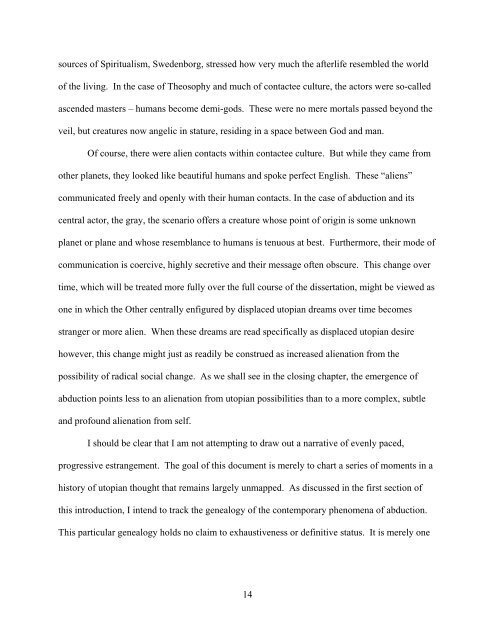A Genealogy of the Extraterrestrial in American Culture
A Genealogy of the Extraterrestrial in American Culture
A Genealogy of the Extraterrestrial in American Culture
Create successful ePaper yourself
Turn your PDF publications into a flip-book with our unique Google optimized e-Paper software.
sources <strong>of</strong> Spiritualism, Swedenborg, stressed how very much <strong>the</strong> afterlife resembled <strong>the</strong> world<br />
<strong>of</strong> <strong>the</strong> liv<strong>in</strong>g. In <strong>the</strong> case <strong>of</strong> Theosophy and much <strong>of</strong> contactee culture, <strong>the</strong> actors were so-called<br />
ascended masters – humans become demi-gods. These were no mere mortals passed beyond <strong>the</strong><br />
veil, but creatures now angelic <strong>in</strong> stature, resid<strong>in</strong>g <strong>in</strong> a space between God and man.<br />
Of course, <strong>the</strong>re were alien contacts with<strong>in</strong> contactee culture. But while <strong>the</strong>y came from<br />
o<strong>the</strong>r planets, <strong>the</strong>y looked like beautiful humans and spoke perfect English. These “aliens”<br />
communicated freely and openly with <strong>the</strong>ir human contacts. In <strong>the</strong> case <strong>of</strong> abduction and its<br />
central actor, <strong>the</strong> gray, <strong>the</strong> scenario <strong>of</strong>fers a creature whose po<strong>in</strong>t <strong>of</strong> orig<strong>in</strong> is some unknown<br />
planet or plane and whose resemblance to humans is tenuous at best. Fur<strong>the</strong>rmore, <strong>the</strong>ir mode <strong>of</strong><br />
communication is coercive, highly secretive and <strong>the</strong>ir message <strong>of</strong>ten obscure. This change over<br />
time, which will be treated more fully over <strong>the</strong> full course <strong>of</strong> <strong>the</strong> dissertation, might be viewed as<br />
one <strong>in</strong> which <strong>the</strong> O<strong>the</strong>r centrally enfigured by displaced utopian dreams over time becomes<br />
stranger or more alien. When <strong>the</strong>se dreams are read specifically as displaced utopian desire<br />
however, this change might just as readily be construed as <strong>in</strong>creased alienation from <strong>the</strong><br />
possibility <strong>of</strong> radical social change. As we shall see <strong>in</strong> <strong>the</strong> clos<strong>in</strong>g chapter, <strong>the</strong> emergence <strong>of</strong><br />
abduction po<strong>in</strong>ts less to an alienation from utopian possibilities than to a more complex, subtle<br />
and pr<strong>of</strong>ound alienation from self.<br />
I should be clear that I am not attempt<strong>in</strong>g to draw out a narrative <strong>of</strong> evenly paced,<br />
progressive estrangement. The goal <strong>of</strong> this document is merely to chart a series <strong>of</strong> moments <strong>in</strong> a<br />
history <strong>of</strong> utopian thought that rema<strong>in</strong>s largely unmapped. As discussed <strong>in</strong> <strong>the</strong> first section <strong>of</strong><br />
this <strong>in</strong>troduction, I <strong>in</strong>tend to track <strong>the</strong> genealogy <strong>of</strong> <strong>the</strong> contemporary phenomena <strong>of</strong> abduction.<br />
This particular genealogy holds no claim to exhaustiveness or def<strong>in</strong>itive status. It is merely one<br />
14















